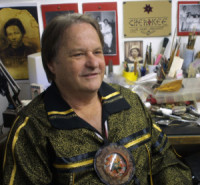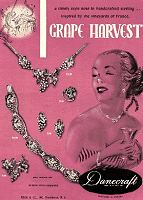
Attending a CJCI Convention: A First-Timer’s Perspective
December 7, 2014
Speakers for CJCI Convention 2015
March 31, 2015by Mary Ann Docktor-Smith – Exclusively for CJCI
The information included in this article was originally presented by Mary Ann Docktor-Smith at the October, 2014 Costume Jewelry Collectors International convention held in Chicago, Illinois.
Whether updating a collection, searching for information about a family heirloom, or assisting a colleague or customer, dating a piece of vintage costume jewelry can present a challenge. Many tools and techniques are familiar to the experienced collector, including dating by textured versus smooth back casting, extended pin stems and simple “C” closures, the presence of a copyright symbol, the use of aurora borealis rhinestones, to name but a few. Less familiar primary sources such as patents and copyrights, books about specific companies, and period advertisements also provide a wealth of information to assist with dating.
For this article, examples from the mid-twentieth century will be provided, though the techniques and tools described here could be used for dating jewelry from other periods.
PATENTS AND COPYRIGHTS
Beginning in the 1930s up to the mid-to-late 1950s, Trifari and Coro patented hundreds of costume jewelry designs. After Trifari won a court case in 1955 for copyright infringement, patenting these types of designs was widely discontinued and replaced by the less-expensive process of design copyrighting. It is obvious that Trifari and Coro patent information can be used to date pieces of their manufacture. However, this information can also be used to assist with dating jewelry made by other companies. The patented designs from a given year or a given decade show the popularity of styles, materials and themes, and indicate the types of findings and the methods of construction being used for the time period.
For example, if researching a necklace with a particular type of clasp, patents like those shown here (click on each image for larger view) filed by Coro might be used as a starting point to dating.
Prior to the early 1950s, typical necklace clasp styles used by Coro and Trifari were spring ring, push (also known as box), or fold-over. In the 1950s, a new type of clasp using a hook and extender became popular for costume jewelry necklaces. The other types of clasps continued to be used, and are still used today. However, if you were dating a necklace that has an original hook-and-extender clasp, you could begin your research with the assumption that the piece was likely made no earlier than the 1950s.
This same process of reviewing Coro and Trifari patents can assist with dating convertible pin/clips, figurals, bracelets by width, etc.
When available, copyright information can be used in the same manner. A great example is jewelry manufactured by Hollycraft during the 1950s. The pieces that were copyrighted by the company were marked with “COPR” (an abbreviation of copyright, used in place of the better-known ©) and also the year as shown in the examples here.
Since Hollycraft was not a huge manufacturer like Coro or Trifari, and had a more defined style, this information is not of great use in identifying general styles of the decade. However, determining findings popularly used is possible. For example, in looking at the use of clip-back and the use of screw-back findings for earrings, a survey of those currently for sale found that from 1950 through 1955, screw-backs were used about 30% of the time, and clip-backs 70 percent of the time. From 1956 through 1959, the survey found no examples of screw-back earring findings on the dated Hollycraft pieces. If attempting to date a pair of earrings with screw-back findings, this information can be used to focus your research to before the mid-1950s.
BOOKS ABOUT SPECIFIC COMPANIES
A second primary-source dating tool is the use of books about fairly-large and prolific costume jewelry manufacturing companies, where original sources have been used by the author. Two great examples are Memoirs of a Fashion Jewelry Manufacturer by Frank R. DeLizza, and Melinda L. Lewis’ The Napier Co.
Florenza-marked jewelry presents a dating challenge, as there are no original records for the company’s production. It is known that they were in business and marking jewelry with the Florenza brand beginning in the early 1950s until the company closed in February of 1981. The author is attempting to date pieces of this jewelry to specific decades. Here is one example:
Frank DeLizza’s book provides great detail about the items the company was manufacturing, with each chapter devoted to a specific time period of just a few years. After summarizing this information in list form, one can note that large navettes and ovals, and givre stones were popular during the years 1957 through 1963. Also during this period, the company is producing necklace, bracelet, pin and earrings sets. Ann Pitman’s Juliana Jewelry Reference was then reviewed, as it includes photos and years of production for many DeLizza and Elster designs. Combining this information and specifics mentioned in these books, the author is dating this Florenza set to circa early 1960s.
Another category of Florenza jewelry for dating research is the selection of large charm bracelets produced by the company, such as the two pictured here (click on images for larger view):
Referencing The Napier Co. by Melinda Lewis, “chunky” charm bracelets of similar design were very popular in the 1950s (see pages 306–308). Other sources confirm dating this style of Florenza charm bracelets to circa 1950s.
PERIOD ADVERTISEMENTS
Advertisements and catalogs, both retail and wholesale, are great sources for determining styles and designs popular during a particular time period. Trifari and Coro advertised extensively during the 1950s, 1960s and 1970s, as did many other costume jewelry companies.
A large number of vintage advertisements and catalogs are available to view online, and the following websites have extensive examples:
Morning Glory Antiques at http://www.morninggloryantiques.com/JewelChat.htm
Many books also include photos of vintage advertisements and catalog pages. For example, in the book Popular Jewelry of the 60’s, 70’s & 80’s by Roseann Ettinger, on page 35, the Florenza design pictured at right appears in a 1963 Sears catalog.
The Palm Royale brooch and earrings design pictured below was found in a vintage advertisement that appeared in “Charm” magazine in December 1946. In an amazing coincidence, the jewelry and the vintage advertisement were found by the author within a three-month period, with the assistance of another CJCI member, Robin Deutsch.
The three key primary dating tools, patents and copyrights, books about specific companies, and period advertisements, can be used as an initial step when researching a particular piece of jewelry. Once primary sources are exhausted, many well-regarded books are great secondary tools for dating. A selection of books can be found in “References and Links” section below.
REFERENCES AND LINKS
For Patent Research:
www.google.com/patents
www.jewelrypatents.com
Collecting Costume Jewelry 202, 2nd Edition by Julia C. Carroll
For Vintage Advertisements and Catalogues:
Morning Glory Antiques at http://www.morninggloryantiques.com/JewelChat.htm
Recommended Books for Dating Information:
Memoirs of a Fashion Jewelry Manufacturer by Frank R. DeLizza
The Napier Co.: Defining 20th Century American Costume Jewelry by Melinda L. Lewis
Popular Jewelry books (1840 to 1940; 1940s and 1950s, and 1960s; 1970s and 1980s) by Roseann Ettinger
Collecting Costume Jewelry 303 by Julia C. Carroll
Answers to Questions About Old Jewelry by C. Jeanenne Bell
Warman’s Costume Jewelry by Pamela Y. Wiggins
Additional Resource:
Summary of dating information compiled from Frank DeLizza’s book
http://www.annasvintagejewelry.com/jewelnotesfrommaryann/jewelnotesjuly2010.html
About the Author
Mary Ann Docktor-Smith is a vintage jewelry collector, historian and dealer. She also creates artisan jewelry using vintage and natural stone beads, polymer clay and cork. Mary Ann is an expert on Selro jewelry, and also Florenza jewelry and the history of Dan Kasoff Inc. She has presented on vintage jewelry topics in several venues, including CJCI Annual Convention, Bead Society of Greater Chicago, Chicago Botanic Garden, and 2007 VFCJ Vintage Jewelry Cruise.
Mary Ann’s two-part article “Costume Jewelry Manufacturing Concepts” appeared in the Fall and Winter 2010 issues of Costume Jewelry Collectors International magazine. She has also written several articles for The Jewelry Ring, including a monthly column, Jewel Notes from Mary Ann.
Before becoming a full-time jewelry dealer, Mary Ann spent many years in the financial services industry, first as a business-owner, and later as a relationship manager with a large international bank. She lives in Chicago with her husband, Randy Smith, and is an avid reader, traveler and gourmet cook.
Visit Mary Ann Docktor-Smith’s website Mary Ann, Mary Ann Designs and Anna’s Vintage at http://www.annasvintagejewelry.com.















